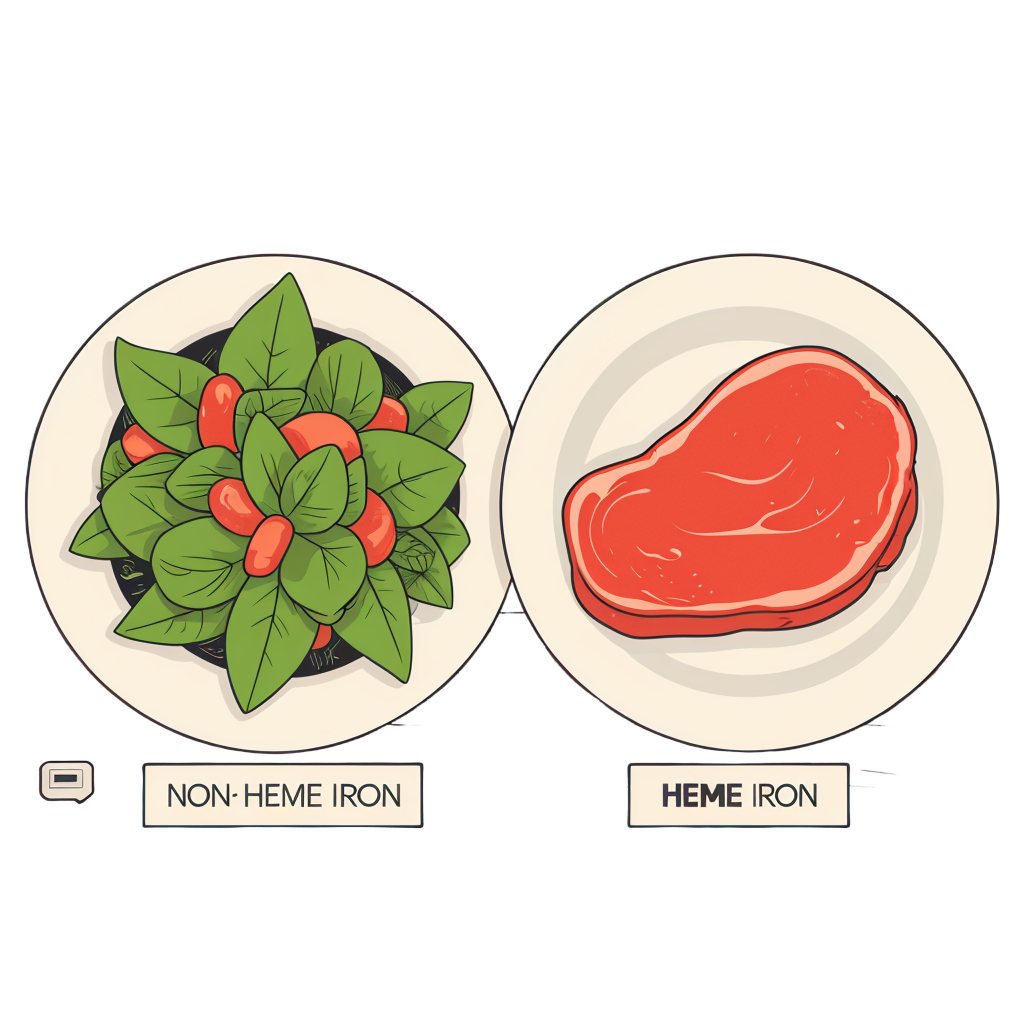There’s limited evidence to support the idea that excess heme iron intake is problematic, as conventional medical science mainly focuses on iron deficiency rather than excess. While medical literature often warns against excessive iron intake, suggesting that it can lead to conditions like hemochromatosis (or ‘iron overload’), the actual causes of hemochromatosis are likely multifactorial. On the other hand, anemia represents a state of iron deficiency.
In today’s diets, the primary source of iron tends to be non-heme iron, which requires significant support from nutrients like vitamin C and other metabolic processes for full assimilation.
While we would welcome any empirical studies suggesting that dietary heme iron can lead to iron overload, many studies fail to differentiate between heme and non-heme iron. This is an example: Study
It’s not surprising that individuals following a meat-free diet may end up with excess non-heme iron, or may be generally iron deficient. Diets devoid of meat can promote an overgrowth of pathogenic microbes that directly compete for and utilize iron. Furthermore, non-heme iron from plant sources can be challenging to absorb in the small intestine, even with the use of supplemental zinc and vitamin C.
Iron
Having adequate iron is necessary for overall health. Iron, next to minerals like sulfur, magnesium, or calcium, are a crucial part of the mineral supply. 70% of our iron directly supports the function of hemoglobin to transport oxygen throughout the circulatory system (bloodstream), and for myoglobin to accept, store, transport, and release oxygen within the muscle tissue.
Kinds of Iron
The two primary categories of iron are heme and non-heme. Non-heme makes up the majority of the iron consumed in the Standard American Diet, where heme is of little quantity because it can only come from meat that isn’t cooked too heavily. Understanding the difference between the two is absolutely crucial when making any advances to rectify internal dis-ease.
Non-Heme Iron
Non-heme is often found as a synthetic additive to foods like bread, or by natural means within plant products and cooked meats. Factors such as being low in iron, the addition of ascorbic vitamin C (ideally from acerola cherry), genetics, consumption of heme iron via meats, has shown to increase the retention of non-heme absorption despite its fairly bio-unavailable quality[1].
One important factor with plant-based diet consumption is the shear amount of consumed carbs in the diet, which basically means a lot of glucose/sugar/blood sugar regardless of how low carb the plant-based diet is. Glucose competes with vitamin C[2], so it is imperative to consider this when trying to stop issues like anemia by consuming enough foods with ascorbic vitamin C.
Now, with a meat-based diet (70+% meat in the diet), there won’t be as much glucose to vitamin C retention competition. If someone were to consume something like beef liver which has a decent amount of vitamin C while consuming very little carbs, they wouldn’t need nearly as much vitamin C, and can do well with the 20mg offered by a 3oz piece of liver to help them assimilate their cooked meats. Though this doesn’t mean we recommend going to town eating well-done meats, as this has proven to create quite a bit of non-heme iron, and the process converts much of the heme available in the meat to non-heme[3].
Heme Iron
“Heme constitutes 95% of functional iron in the human body, as well as two-thirds of the average person’s iron intake in developed countries.”
https://www.ncbi.nlm.nih.gov/pmc/articles/PMC3967179/
Whether it’s heme upon consumption, or broken down into heme via non-heme, heme is king for all things circulatory health in order to prevent debilitating issues like anemia. While we can use various complex methods to acquire heme iron via non-heme, it is highly recommended that the individual eats meat rich in heme iron, and to cook that meat as little as possible so to acquire a heavier dose of heme iron. Spending less energy in the process of digestion is an ideal method to enhance internal self-healing in a way of getting to a fasted state; detailed more in our article on fasting.
Early Signs of Anemia
A very important part of investigating a root cause is to start with smaller signs that otherwise seem like they’re not connected to the issue at all.
Simple Tricks
We wanted to provide the reader with a few decent ways of determining anemia on the cheap, though keep in mind that they’re not very conclusive and lab testing is recommended:
- Finger press: Take the affected individuals thumb and press firmly on the nail for about 10 seconds, and then let go. If the blood doesn’t fill back up immediately, then this can be a sign of anemia.
- Slow wound healing: Now don’t go and cut yourself and tell your family that Asa at Gut Goals told you to do it. But if the individual suspected of having anemia is ever in a situation where they’re wanting a wound to heal, being anemic can make this process quite slow. Though keep in mind that they can also have high testosterone and heal the wound pretty quickly while also anemic.
- Skin tone: This is always a good measure of determining anemia because having healthy blood leaves a bit of a glow in the skin where the anemic are often pale. Keep in mind that this method is very primitive and inconclusive where ethnic origin/genetics play a role, and some people can naturally be very white in the hue of their skin.
Neuropsychiatric Disorders and Anemia
Because B12 deficiency is a huge cofactor often deficient in many individuals which has shown to lead to anemia. It’s important to look to the disorders associated with lack of B12 to see a connection to better understand the root cause. We also have an article on how MTHFR and pathogens like C. albicans connect to destabilize the methylation of crucial B vitamins like B12.
Below is a list of neuropsychiatric disorders/conditions and symptoms associated with B12 deficiencies:
- P0 peripheral neuropathy
- Myeloneuropathy
- Cerebellar ataxia
- Optic atrophy
- Mood disorders
- Psychosis
- Personality changes
- Loss of memory
- Depression
- Dementia
- Confusion
- Schizoferniform status
- OCD
Understanding if someone is affected by one of these conditions can lead someone to believe that anemia may be a factor in their health as well, but not in all cases.
I Eat a Lot of Meat, Why Am I Still Anemic?
It’s one thing to look pale-skinned due to genetics of living in colder climates, but another to lack that warm glow when it really should be there regardless of genetics. Harsh reality checks like this can be hard to swallow, especially for those who consume plant-based diets with the idea that they can acquire enough heme iron naturally or otherwise, but aren’t. However, there are some who, no matter how much meat they eat, aren’t getting enough iron. So why is that?
Microbes and Anemia
So if someone is eating a lot of meat, and not getting enough heme iron, they should consider how the small intestine plays a part.
“The absorption of most dietary iron occurs in the duodenum and proximal jejunum and depends heavily on the physical state of the iron atom. At physiological pH, iron exists in the oxidized, ferric (Fe3+) state. To be absorbed, iron must be in the ferrous (Fe2+) state or bound by a protein such as heme.”
https://pubmed.ncbi.nlm.nih.gov/26428277/
Guess who likes to hang out in the small intestine, specifically the duodenum? Lactobacillus plantarum.
Apparently, it’s quite possible that these species of lacto-fermenting bacteria are responsible for a good amount of our iron absorption, though it isn’t quite clear their role in heme iron vs. non-heme – it’s safe to assume that non-heme is generally what they’ve been supporting[4]; we also can’t know if the bacteria support both non-heme from cooked meats and plants. I’d speculate that the direct antibiotic damages that kill off these bacteria in the small intestine are a big part of the multifactorial issue that is anemia.
Hereditary Anemia
Sometimes health really is about rolling the dice, and genetics are one factor that can seem entirely irreversible, even for a really optimal meat-eater. Below are some significant examples of what can directly contribute to someone becoming anemic through genetic dysfunction, though keep in mind that we don’t believe that having one or more of these is an anemia for life death sentence:
Thalassemia
With thalassemia, the human body is generally unable to produce enough hemoglobin, and therefore struggle with blood-oxygen.
Fanconi anemia
This one can be particularly dangerous for someone who doesn’t work to replenish white blood cells (WBCs) continually. Fasting is a great way to regenerate the immune system! Fanconi anemia is associated with bone marrow being unable to produce enough blood cells for great circulatory health and further is much more susceptible to microbial disease because their production of WBCs is gimped significantly.
Sickle-cell anemia
This guy causes our blood protein hemoglobin to form abnormally. It generally impairs immune health and raises susceptibility to infection, but is generally exclusive to certain races such as African Americans, Indians, Hispanics, and Mediterraneans.
Hereditary spherocytosis
Frail red blood cells known as spherocytes are the hallmark of hereditary spherocytosis. This condition is a bit of a danger zone in that red blood cells will clump up in the spleen because they can’t change shape and move through various organs as normal red blood cells do.
Congenital pernicious anemia
Thankfully this is pretty rare, but with this genetic disorder the individual will have no ability to produce intrinsic factor which is a protein necessary to help us absorb vitamin B12. B12 is necessary to produce enough red blood cells in order to prevent issues like anemia.
Thrombotic thrombocytopenic purpura
Blood platelets help us to heal wounds, and thrombotic thrombocytopenic purpura – who comes up with these names? Just abbreviate this to TTP. TTP is a particularly complex issue in that the affected person has a faulty enzyme that normally supports blood-clotting where platelet counts drop which results in less wound repair. This can lead to internal, external, and below the skin bleeding, but the main issue is when the blood cells leave the bone marrow where they then have breakages which leads to anemia. This is called hemolytic anemia.
Nutritional Causes of Anemia
Too much Calcium: As it turns out, iron competes with calcium[5].This premise alone makes us look to the individual’s diet.
Ex-vegetarian? Carnivore with dairy inclusion? The calcium in dairy products may be gimping your assimilation of iron, among other factors like gut dysbiosis.
Too little B12: As briefly mentioned above, we need B12 to produce more red blood cells, and so this can be a significant problem for people who are overcooking their meats, as B vitamins are among the majority of nutrients offered in meat to fall off by around 60% when cooking because they’re water soluble. However, when the juices are retained, all of the minerals stick around with 90% of the B vitamins[6].
Well That’s Lame, Now What?
We at Polarity Health bet that if someone were to remove or reduce dairy, up liver consumption, set the playing field for lacto-bacteria to flourish (BIG separate subject), and cook their meats via a meat-centric diet as rare as possible, they won’t have much trouble absorbing iron over a period of time even when plagued by a genetic dysfunction. We also believe that with what science is available[7], that fasting is a great option to influence gene expression, and can quite possibly down regulate the genetic expression of these disorders in theory.
†The statements made here have not been evaluated by the FDA. This product is not intended to diagnose, treat, cure, or prevent any disease.
†The information provided on this site is intended for your general knowledge only and is not a substitute for professional medical advice or treatment for specific medical conditions. You should not use this information to diagnose or treat a health problem or disease without consulting with a qualified healthcare provider. Please consult your healthcare provider with any questions or concerns you may have regarding your condition. Never disregard professional medical advice or delay in seeking it because of something you have read on this website.
†In the event of a medical emergency, call a doctor or 911 immediately. Reliance on any information provided by this website is solely at your own risk.




